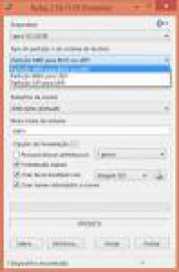
Free Open Source USB Boot Utility Pete Batard originally launched Rufus in 2011 as a free open source program for USB DOS bootable flash drives, replacing the Windows HP USB Disk Formatting Tool (HUDSFT). Several updates have appeared over the years, and 2020 comes with a more modern, more stable version than before. The most significant changes were updates to support ISO images, UEFI launches and Windows This is Rufus? Rufus formats USB flash drives, allowing you to boot a computer that is missing or has a damaged operating system (OS). Creates installation files from boot ISOs, especially on operating systems such as Linux, UEFI, and Microsoft Windows. You can also use it to flash BIOS or other DOS (function () {(‘review-app-page-desktop’);}); It used to be common to create ISO images using popular tools such as InfraRecorder or CDBurnerXP. With the advancement of technology, Pete Batard decided to create a USB installer when he got tired of his own software. HUDSFT was limited in certain features, so it accepted the challenge of developing a software clone that would be offered for review and highlighted the benefits of using Rufus as a USB flash drive utility. One of the most important aspects is the constant updates that help keep the software up to date. Here is a short list of different versions that support the following systems: ISO: Updated support for MS-DOS and :: Language: Windows To: Compatibility for Windows Vista and XP machines How to create a Rufus boot drive Before you start can create a Rufus USB installer, several prerequisites must be met. At the top of this list, get the ISO for the operating system you intend to use, e.g. B. Windows 7 or 10. If you claim to be downloading, you will need to check that it is safe and without malware or you received the correct ISO image, you need the latest Rufus and USB memory. If the requirements are met, you can insert an external device into the computer and run the software program. Rufus will automatically detect if there is USB, so there is no need to search, just go to the Boot Choice drop-down menu and select the disc or ISO image. To the right of the tabs you need to click Choose what will open Windows Explorer. You will need to find and open your ISO images so that Rufus knows which image to see and can see that when you click select, there is a download option. The latest version of Rufus offers you files for Windows 8 and 10 if you can’t find them. You will be asked which ones you want to download and you can continue with the process after choosing the default installation of Windows. Rufus will determine the correct partitioning scheme for your computer. You need to create a volume label and decide if you want to change the default cluster size and file system settings. After you click Start, the software will start creating a USB memory. During the creation process, you may receive an error message that the flash drive is not large enough. In this situation, it is best to buy a USB with more storage space. Do you also need to format the first device to delete the files you tried to start Windows 10 from the USB device? With the latest updates, Rufus can run Windows 10 directly from a USB device. You must first obtain the appropriate license to avoid legal action or copyright issues with Microsoft. When you are ready to change yoursoperating system, you can insert a flash drive into the computer, press and hold or press the right keyboard shortcut to change the boot location. You can specify that you use a USB flash drive to boot and guide you through setting up Windows 10. The system runs a little slower than your flash drive because it has fewer resources you can rely on than your computer. There is also a hint that no software update is planned to include multiple charging. However, with a little tweaking, that doesn’t mean it’s impossible to need a second, larger flash drive to function as a multi-boot USB device. You can follow the same steps above to create a bootable USB via Rufus, followed by copying the ISO files to a multiple charger. When you’re done, just reconnect Rufus USB, select a different operating system, and watch the software format the device in preparation for the new operating system. You can copy new files to your multiboot device in separate software, what is the best way to create a USB boot device? One of Rufus’ biggest competitors is UNetbootin. Judging by these two programs only by ratings, Rufus is the number one utility for USB flash drives in the world, while UNetbootin is ninth on the list. The main reason for this setting is that Rufus will automatically detect your flash drive, reducing the risk of accidental heavy formatting of your computers. Create a new USB operating system installation program. Although Rufus’ process may seem complicated at first, it becomes easier over time. You can use the software to create a multiple charger on another device that offers higher speeds and more space. If you can’t start your computer or your operating system is damaged, using Rufus to create a bootable boot system is the right way to go.
| Download uTorrent |
- Rufus 64-Bit & 32-Bit nay nay download torrent
